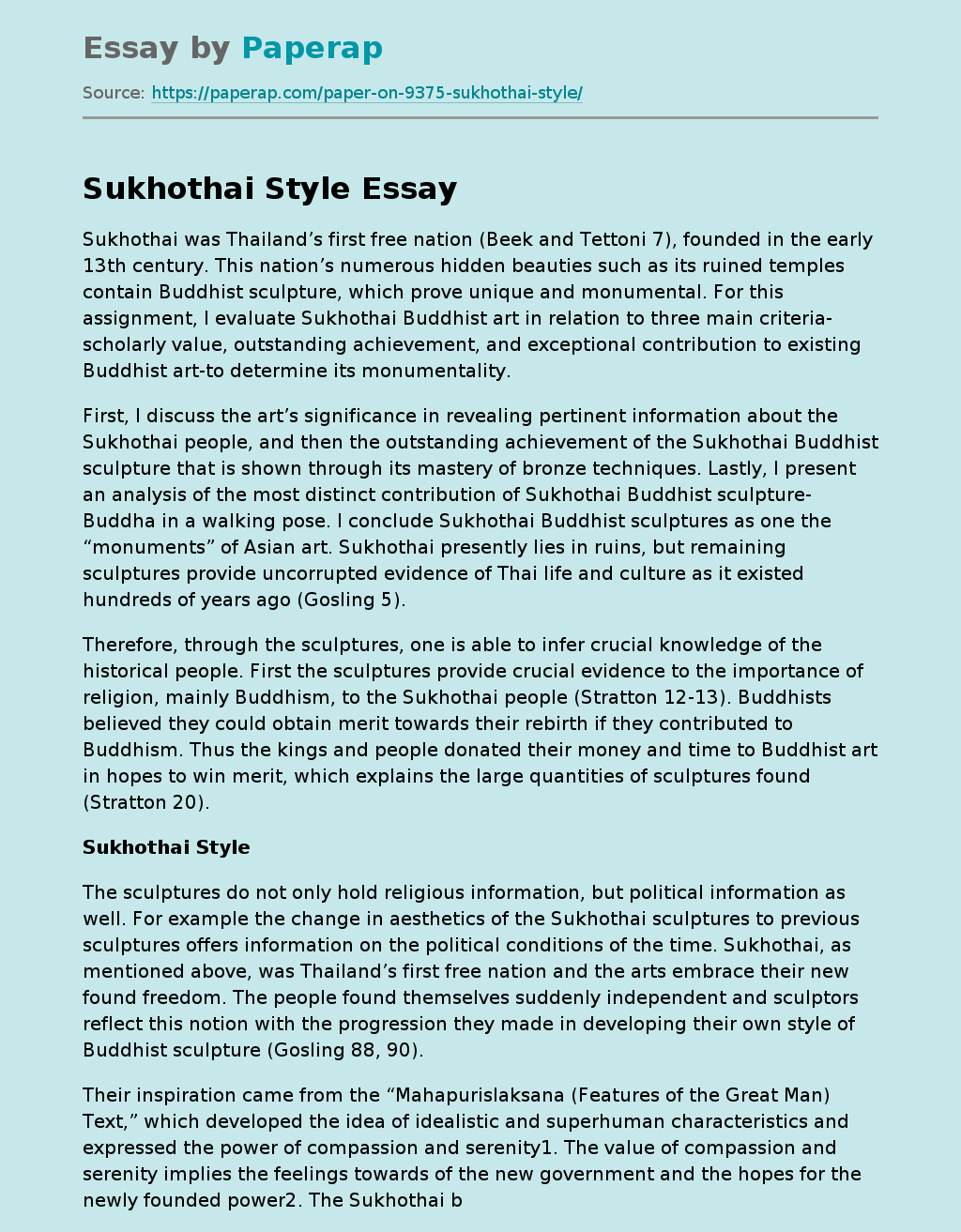The following sample essay talks about Thailand’s first free state, Sukhothai. Read the introduction, body and conclusion of the essay, scroll down.
Sukhothai was Thailand’s first free nation (Beek and Tettoni 7), founded in the early 13th century. This nation’s numerous hidden beauties such as its ruined temples contain Buddhist sculpture, which prove unique and monumental. For this assignment, I evaluate Sukhothai Buddhist art in relation to three main criteria-scholarly value, outstanding achievement, and exceptional contribution to existing Buddhist art-to determine its monumentality.
First, I discuss the art’s significance in revealing pertinent information about the Sukhothai people, and then the outstanding achievement of the Sukhothai Buddhist sculpture that is shown through its mastery of bronze techniques. Lastly, I present an analysis of the most distinct contribution of Sukhothai Buddhist sculpture-Buddha in a walking pose. I conclude Sukhothai Buddhist sculptures as one the “monuments” of Asian art. Sukhothai presently lies in ruins, but remaining sculptures provide uncorrupted evidence of Thai life and culture as it existed hundreds of years ago (Gosling 5).
Therefore, through the sculptures, one is able to infer crucial knowledge of the historical people. First the sculptures provide crucial evidence to the importance of religion, mainly Buddhism, to the Sukhothai people (Stratton 12-13). Buddhists believed they could obtain merit towards their rebirth if they contributed to Buddhism. Thus the kings and people donated their money and time to Buddhist art in hopes to win merit, which explains the large quantities of sculptures found (Stratton 20).
Sukhothai Style
The sculptures do not only hold religious information, but political information as well.
For example the change in aesthetics of the Sukhothai sculptures to previous sculptures offers information on the political conditions of the time. Sukhothai, as mentioned above, was Thailand’s first free nation and the arts embrace their new found freedom. The people found themselves suddenly independent and sculptors reflect this notion with the progression they made in developing their own style of Buddhist sculpture (Gosling 88, 90).
Their inspiration came from the “Mahapurislaksana (Features of the Great Man) Text,” which developed the idea of idealistic and superhuman characteristics and expressed the power of compassion and serenity1. The value of compassion and serenity implies the feelings towards of the new government and the hopes for the newly founded power2. The Sukhothai began placing their new values into existing Buddha sculptures, resulting in magnificent original pieces of art. The following is a comparison of an earlier sculpture to a latter sculpture:
The Sukhothai artists has moved away from previously held conventions of the Buddha and appear to have made deliberate attempts to break off from earlier prototypes (Gosling 88). For example, the Buddha on the left has broad faces and fleshiness which is characteristic of Lanna sculptors (Gosling 86). Contrastingly, the Buddha on the right has “tapered and petal-like” (Gosling 88) fingers, a more pleasant countenance, and a highly stylized figure (Gosling 86-87). The Sukhothai Buddhist sculptures not only reflect religious or political importance, but also a great accomplishment of the people.
Thailand’s First Free State Sukhothai. (2019, Dec 05). Retrieved from https://paperap.com/paper-on-9375-sukhothai-style/

